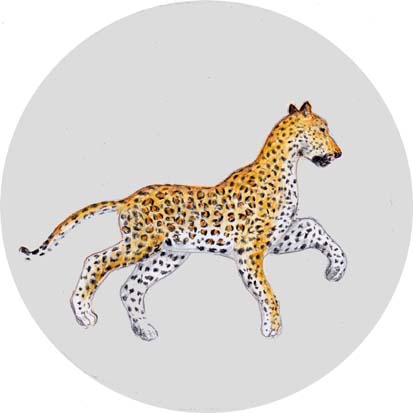Art on Lead Tokens
Coins from Ancient Ruhuna
These lead tokens were found in last two decades of 20th century,
buried around Tissamaharama in Sri Lanka and are dated to 200 BCE. to
200 CE. Lead is used in many of early coins because probably of low
melting point. Most are unique and not found in hoards, so unlikely to
be coins. They maybe tokens buried in the foundation of houses as is
the custom even today. They are very small weighing few grams at most
and less than an inch in diameter.
This attempt is not the traditional line drawing of coin, but an
attempt to visualize what may have been represented on the coin.
Trying to interpret what the ancient Artist who made the token
may have tried to illustrate on the token, to aid someone who looks at
the token to see some of the detail which is otherwise missed. The
ancient art that is illustrated on these lead coins can only be
visualized by an artist and not with a camera which can never capture
the exact stance and perspective.
Coloured Artwork which are realistic representations of the stylised
drawing on coin is by Wildlife Artist
Sanjaya Weeratunge.
The adopted methodology is to start with tracing the outline of an
enlarged print-out the coin scan on A4 paper. When painting the artist
deviates from outline as little as possible to get a realistic
representation of the Animal or Human figure. In this way the drawing
can be super-imposed on the coin image after appropriate scaling.
We started with 10 Tokens, which he has now completed in the COVID-19
lockdown. We fine tuned the art with Proof sent by email and he
brought them to me after the curfew. The artwork has now been scanned,
scaled to the size of coin, and have been posted below.
Wilfried Pieper's Line drawing of 8 of these coins from the 1999 book
Ruhuna. The Ancient Civilization Re-Visited
by by Osmund Bopearachchi and Rajah M. Wickramasinhe are also included
for reference.
Those lead tokens were obtained in 2016 from Lalith Raddella in
Colombo who had purchased a selection from Raja Wickramasinghe.
When I sent this page to Wilfried Pieper for comment he said I quote
"The images done by the artist are simply wonderful!
I Thank him for his encouraging words which will motivate me
to ask Sanjaya to paint more of the lead tokens for me.
I included 2 of the images in a
lecture
I gave at the 1st Newman Numismatic Portal Symposium on 2020 August 30th,
and this page was
reviewed
by Wayne Homren in the E-sylum of 2020 September 6th.
Please send any comments to me via email kavanr @ gmail.com
Please use browser in full widescreen mode on a computer monitor.
If on Phone Rotate to landscape and don't use Simplified View.
The individual webpages for each token has been linked to OBRW-ID
given between each pair of images.
| Obverse
| OBRW-ID
| Sanjaya Art
| Line Drawing and comments
|
 |
R1
|  | Leopard pouncing
|
 |
A5
|  |

Sathdhantha Elephant. The word Sathdantha is used on an Elephant
which has Seven points of his body touch the ground.
|
 |
A7
|  |


The obverse of coin used on the cover page of OBRW book. Identified as
a stylised lion to right, looks like a lizard as the whipped tail
extends behind the hind legs at the same size of body before thinning
out. The oversize paws and the pointed head looks like that of a Monitor.
|
 |
A17
|  |

Both sides of this coin used on the cover page of OBRW book.
|
 |
A22
|  |

Obv: Described in OBRW as a Maneless lion, looks more like a Deer as
the legs are long relative to body. The square above is not connected
to the short tail.
|
 |
E11
|  | Lion

|
 |
E12
|  |


Obv: Described in OBRW as a lion jumping, looks like an antelope in
flight. The pair of hind legs curved up, the short stubby tail, a
pointed head with antlers.
|
 |
F1
|  |

Obv: Described in OBRW a lady with Mirror.
Note the long plait of hair divided in two at the end, as used even today.
|
 |
F13
|  |


Plate Image of F13 in OBRW and size matches specimen. But Line Drawing and
Weight of 4.135 grams does not match published Weight of 2.11 grams.
Obv: Horse running right has hind legs back.
|
 |
X3
|  |
Obv: Sambar with wide antlers
Rev: Brahami around dot at center
|
Part of the website
coins.lakdiva.org.lk
for detailed information about coins that circulated in Lanka
since 300 BCE.






























